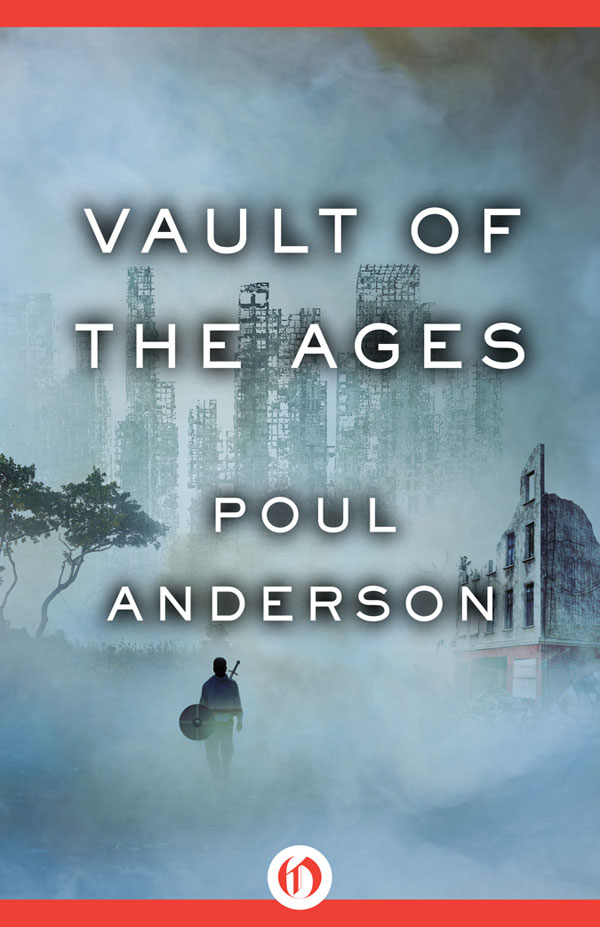Vault of the Ages
Authors: Poul Anderson



FRESH EBOOK DEALS, DELIVERED DAILY
BE THE FIRST TO KNOW—
NEW DEALS HATCH EVERY DAY!
Poul Anderson

To Mor and John
A
RCHAEOLOGISTS
, studying the past, are handicapped by the fact that relics are usually few and in poor condition. Often, one is not even sure where to look for them. Out of such finds—from tombs, ruined cities, swamps, deserts, and any other place where men of the past have left some trace of themselves—the archaeologist tries to build up a picture of these men’s lives and civilizations. But there are great gaps in our knowledge and probably always will be. For instance, we cannot yet read the inscriptions left by the ancient Cretans, and so are in the dark about many features of their high civilization. We know almost nothing of their actual history, and we are not even sure who the people were that finally destroyed them. In like manner, there are many things we would like to know about the Etruscans, Khmers, Mayans, and other important nations and tribes of the past; but we have simply not found enough complete records and relics to have a good picture.
Hundreds of years from now, our own modern civilization may be as remote and mysterious as these cultures. As in this story, where I have laid the scene five hundred years in the future, after our present-day civilization was destroyed by the misuse of the atom bomb, the wise men of that day would be able to learn what we were like from time capsules.
As to what a time capsule is, many definitions could be given, but let us stick to the facts. “Time capsule” is a coined name for a container of some kind which is filled with pictures, models, and
other records which give a view as complete as possible of the world of the time—how the people lived, what they ate and wore and knew and thought. The container is then buried in a safe place for scientists of the far future to dig up.
The idea of leaving tokens for the future is not entirely new. Such inscriptions as the great one on the Rock of Behistun, in Asia Minor, were made so that all men to come would know of the king who had ordered it. When a Chinese emperor in the third century
B.C.
tried to destroy certain texts, scholars hid copies in the hope that later generations would find them. This hope was realized, and so such writings as the Confucian Willow Books were saved for posterity. However, no such systematic attempts as we are discussing were, to my knowledge, made before the twentieth century. This is probably because of the difficulty of reconstructing the past, and because only since Schliemann’s time has there been any real science of archaeology.
I believe there are only two time capsules in existence—one at Atlanta, Georgia, and one in New York City, which is the best known.
This time capsule was made by the Westinghouse Company and was buried in 1938 on the site of the World’s Fair of 1939. It was meant to be dug up again in five thousand years, in
A.D
. 6938. A Book of Record was prepared and 3,650 copies printed on permanent paper with special ink. This Book of Record describes the contents, the exact location, and the purpose of the time capsule. It also contains a request that it be translated into new languages as they appear. However, in case this is not done, the book contains a carefully worked-out phonetic and linguistic key to the English language, from which any trained linguist can reconstruct our tongue. One copy was placed in the time capsule itself; the rest, distributed to libraries, museums, monasteries, lamaseries, temples, and other safe places around the world. It is hoped that some few copies, at least, will last the full five thousand years. Even if none does, the capsule will probably be found someday, for the site of New York City will always be of great interest to future archaeologists.
The capsule itself is a torpedo-shaped vessel, seven and one-half feet long and eight and three-eighths inches in diameter, made of cupraloy (a very resistant alloy of copper) one inch thick. Inside, it is lined with Pyrex glass and, after being packed and the air pumped
out, it was filled with humid nitrogen to preserve the contents from decay and corrosion. It was lowered fifty feet into the earth through a steel pipe to a base of waterproof concrete. Pitch was poured in around it, then a top layer of concrete, after which the pipe was cut off and pulled out and the hole was filled in. With these precautions it should be safe from vandals such as the grave robbers who destroyed much valuable material in the Egyptian pyramids; and geologists have assured us that in five thousand years the land will not have sunk below the sea. The time capsule should easily last its appointed period.
The shell contains messages to the future from prominent men, a copy of the Book of Record and one of the Bible, and various technical aids to translators. There are numerous articles of common usefulness, pleasure, clothing, and vanity, such as a watch, hats, games, money, seeds, pipe and tobacco pouch, and so on. There are also a magnifier and a viewer for the microfilmed texts and the newsreel. This newsreel is a sound film running about fifteen minutes and showing characteristic or significant events of the year 1938—scenes from military maneuvers and the Sino-Japanese War then taking place, a fashion show, a Presidential address, and so on.
On microfilm, there are a great many texts which are meant to give as complete a picture as possible of the world of 1938. There are photographs of industrial processes and works of art; books and encyclopedic articles describing what we knew and did and thought; some outstanding novels and dramas of the twentieth century; and even comic strips.
The entire capsule is, indeed, a treasure chest of information about our own lives and times, not only the great events and discoveries, but the small details of everyday living.
The one at Atlanta is, as far as I know, quite similar, though it contains more models of machinery, houses, and so forth. Probably more time capsules will be laid down from time to time in the future.
As the repository described in this book is not entirely like these, I have called it a “time vault” instead. It was not meant purely for wise men or scientists, but for the common men of the future, whom the maker foresaw would have sunk back to a barbaric state of life. He wanted them to find and enter the vault easily, and use its contents as a guide to rebuilding civilization. To facilitate this, he put his relics in a large cellar or vault underground, lined with
concrete so it would not collapse, and left a door above ground for anyone who wished to enter. He did not microfilm his books, since these people of the future would probably not understand what he had done. Instead, he left them in steel cabinets with close-fitting doors, safe from animals, insects, fire, and damp. He chose books which would be easy to read and understand, as well as more complicated ones when the simple texts had been mastered. And he left plans and models not only of the great machines we now have, such as automobiles and airplanes, but also of things which backward peoples could make for themselves right away—balloons, windmills, schooners, simple blast furnaces, and the like. It was his hope that the people of the future would go on from this to make the more powerful machines of his own time. And he left them also the great works of art, literature, religion, and philosophy, hoping that these would teach men to use the machines wisely.
PA.
Warriors of Lann
T
HE SUN
was low, slanting its long light through the forests to north and west, and shadows crept over the rolling green farm lands across which Carl had come riding. He saw the buildings ahead as an outlined darkness against the trees beyond, heard noises of cattle and sheep and a barking dog drift through the quiet, and felt his pony break into a trot as it smelled hay and shelter. A wandering sunset breeze ruffled Carl’s long hair. He shaded his eyes against the light and leaned forward in the saddle, eager as his horse. It had been a long day’s ride.
The dog came running from the farmyard and danced yammering around him as he neared the house. Carl’s hand tightened on the hilt of his sword—watchdogs often attacked on these lonely places and had to be beaten off with the flat of a weapon. This one, however, simply kept barking till the evening rang with echoes.
“You there, Bull! Quiet!”
A man stepped out of the house and the dog ran to him and was still. The man remained in the door, waiting with a spear in his hand. He was big and burly, with gray hair that reached to his shoulders and a beard that flowed over his homespun shirt. Two boys stood behind him with axes in their hands.
Carl, smiling, reined in his pony. “Greetings,” he said. “I come alone and in peace, asking a roof for the night.”
The farmer lowered his spear and nodded. “Then be welcome and stay with us,” he replied formally. “I am John, son of Tom, and a Dalesman.”
“And I am Carl, son of Ralph in Dalestown,” answered the newcomer. “I thank you for your kindness.”
“Ralph—in Dalestown!” John’s eyes widened. “Then you must be the son of the Chief.”
“Yes, I am,” Carl said, swinging out of the saddle.
They stood for a moment looking at him. Carl was sixteen years old, but large and strong for his age, with ruddy brown hair, and sun-tanned face and wide-set brown eyes. He wore the usual clothes of a traveler: leather breeches, dyed wool shirt, short homespun cloak, and moccasins. Sword and dagger were belted at his waist and a round shield hung from his saddle beside a bow and quiver. He had a canteen of water but no other supplies; in the wilderness there was plenty of game, and where men lived, a farmer would always give him food and lodging for the sake of company and news.

